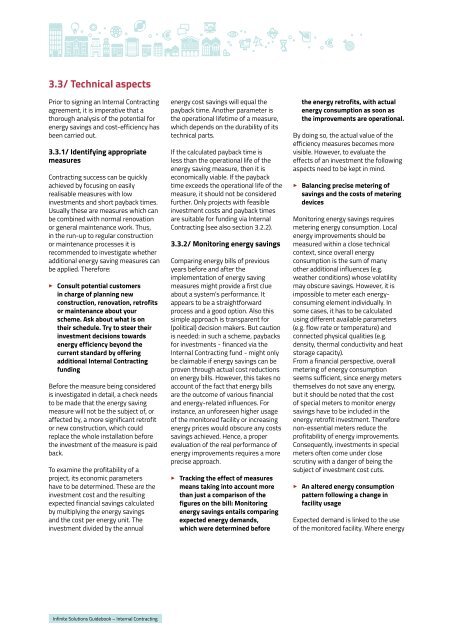Contracting
guidebook_intracting_web
guidebook_intracting_web
You also want an ePaper? Increase the reach of your titles
YUMPU automatically turns print PDFs into web optimized ePapers that Google loves.
3.3/ Technical aspects<br />
Prior to signing an Internal <strong>Contracting</strong><br />
agreement, it is imperative that a<br />
thorough analysis of the potential for<br />
energy savings and cost-efficiency has<br />
been carried out.<br />
3.3.1/ Identifying appropriate<br />
measures<br />
<strong>Contracting</strong> success can be quickly<br />
achieved by focusing on easily<br />
realisable measures with low<br />
investments and short payback times.<br />
Usually these are measures which can<br />
be combined with normal renovation<br />
or general maintenance work. Thus,<br />
in the run-up to regular construction<br />
or maintenance processes it is<br />
recommended to investigate whether<br />
additional energy saving measures can<br />
be applied. Therefore:<br />
3 Consult potential customers<br />
in charge of planning new<br />
construction, renovation, retrofits<br />
or maintenance about your<br />
scheme. Ask about what is on<br />
their schedule. Try to steer their<br />
investment decisions towards<br />
energy efficiency beyond the<br />
current standard by offering<br />
additional Internal <strong>Contracting</strong><br />
funding<br />
Before the measure being considered<br />
is investigated in detail, a check needs<br />
to be made that the energy saving<br />
measure will not be the subject of, or<br />
affected by, a more significant retrofit<br />
or new construction, which could<br />
replace the whole installation before<br />
the investment of the measure is paid<br />
back.<br />
To examine the profitability of a<br />
project, its economic parameters<br />
have to be determined. These are the<br />
investment cost and the resulting<br />
expected financial savings calculated<br />
by multiplying the energy savings<br />
and the cost per energy unit. The<br />
investment divided by the annual<br />
energy cost savings will equal the<br />
payback time. Another parameter is<br />
the operational lifetime of a measure,<br />
which depends on the durability of its<br />
technical parts.<br />
If the calculated payback time is<br />
less than the operational life of the<br />
energy saving measure, then it is<br />
economically viable. If the payback<br />
time exceeds the operational life of the<br />
measure, it should not be considered<br />
further. Only projects with feasible<br />
investment costs and payback times<br />
are suitable for funding via Internal<br />
<strong>Contracting</strong> (see also section 3.2.2).<br />
3.3.2/ Monitoring energy savings<br />
Comparing energy bills of previous<br />
years before and after the<br />
implementation of energy saving<br />
measures might provide a first clue<br />
about a system’s performance. It<br />
appears to be a straightforward<br />
process and a good option. Also this<br />
simple approach is transparent for<br />
(political) decision makers. But caution<br />
is needed: in such a scheme, paybacks<br />
for investments - financed via the<br />
Internal <strong>Contracting</strong> fund - might only<br />
be claimable if energy savings can be<br />
proven through actual cost reductions<br />
on energy bills. However, this takes no<br />
account of the fact that energy bills<br />
are the outcome of various financial<br />
and energy-related influences. For<br />
instance, an unforeseen higher usage<br />
of the monitored facility or increasing<br />
energy prices would obscure any costs<br />
savings achieved. Hence, a proper<br />
evaluation of the real performance of<br />
energy improvements requires a more<br />
precise approach.<br />
3 Tracking the effect of measures<br />
means taking into account more<br />
than just a comparison of the<br />
figures on the bill: Monitoring<br />
energy savings entails comparing<br />
expected energy demands,<br />
which were determined before<br />
the energy retrofits, with actual<br />
energy consumption as soon as<br />
the improvements are operational.<br />
By doing so, the actual value of the<br />
efficiency measures becomes more<br />
visible. However, to evaluate the<br />
effects of an investment the following<br />
aspects need to be kept in mind.<br />
3 Balancing precise metering of<br />
savings and the costs of metering<br />
devices<br />
Monitoring energy savings requires<br />
metering energy consumption. Local<br />
energy improvements should be<br />
measured within a close technical<br />
context, since overall energy<br />
consumption is the sum of many<br />
other additional influences (e.g.<br />
weather conditions) whose volatility<br />
may obscure savings. However, it is<br />
impossible to meter each energyconsuming<br />
element individually. In<br />
some cases, it has to be calculated<br />
using different available parameters<br />
(e.g. flow rate or temperature) and<br />
connected physical qualities (e.g.<br />
density, thermal conductivity and heat<br />
storage capacity).<br />
From a financial perspective, overall<br />
metering of energy consumption<br />
seems sufficient, since energy meters<br />
themselves do not save any energy,<br />
but it should be noted that the cost<br />
of special meters to monitor energy<br />
savings have to be included in the<br />
energy retrofit investment. Therefore<br />
non-essential meters reduce the<br />
profitability of energy improvements.<br />
Consequently, investments in special<br />
meters often come under close<br />
scrutiny with a danger of being the<br />
subject of investment cost cuts.<br />
3 An altered energy consumption<br />
pattern following a change in<br />
facility usage<br />
Expected demand is linked to the use<br />
of the monitored facility. Where energy<br />
Infinite Solutions Guidebook – Internal <strong>Contracting</strong>


